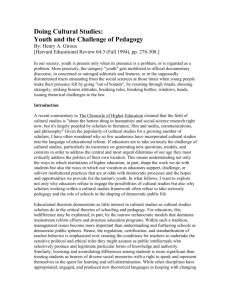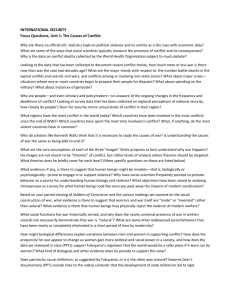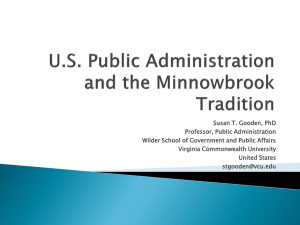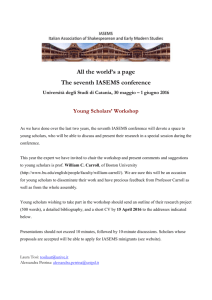Critical` Peace Education - Teachers College Columbia University
advertisement
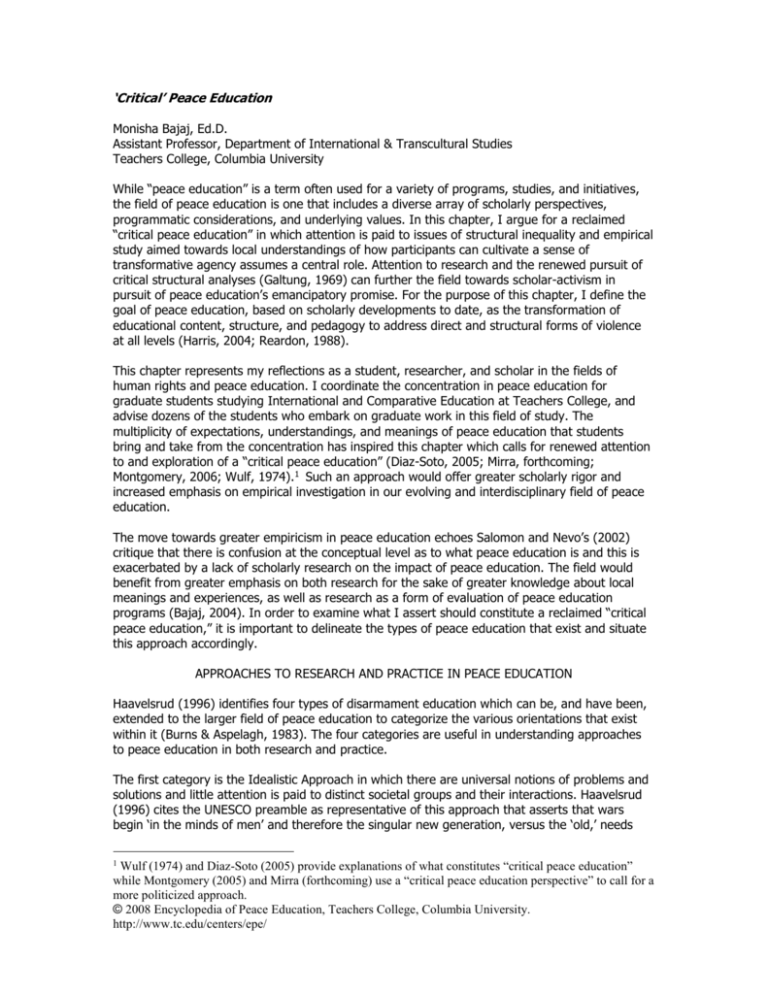
‘Critical’ Peace Education Monisha Bajaj, Ed.D. Assistant Professor, Department of International & Transcultural Studies Teachers College, Columbia University While “peace education” is a term often used for a variety of programs, studies, and initiatives, the field of peace education is one that includes a diverse array of scholarly perspectives, programmatic considerations, and underlying values. In this chapter, I argue for a reclaimed “critical peace education” in which attention is paid to issues of structural inequality and empirical study aimed towards local understandings of how participants can cultivate a sense of transformative agency assumes a central role. Attention to research and the renewed pursuit of critical structural analyses (Galtung, 1969) can further the field towards scholar-activism in pursuit of peace education’s emancipatory promise. For the purpose of this chapter, I define the goal of peace education, based on scholarly developments to date, as the transformation of educational content, structure, and pedagogy to address direct and structural forms of violence at all levels (Harris, 2004; Reardon, 1988). This chapter represents my reflections as a student, researcher, and scholar in the fields of human rights and peace education. I coordinate the concentration in peace education for graduate students studying International and Comparative Education at Teachers College, and advise dozens of the students who embark on graduate work in this field of study. The multiplicity of expectations, understandings, and meanings of peace education that students bring and take from the concentration has inspired this chapter which calls for renewed attention to and exploration of a “critical peace education” (Diaz-Soto, 2005; Mirra, forthcoming; Montgomery, 2006; Wulf, 1974).1 Such an approach would offer greater scholarly rigor and increased emphasis on empirical investigation in our evolving and interdisciplinary field of peace education. The move towards greater empiricism in peace education echoes Salomon and Nevo’s (2002) critique that there is confusion at the conceptual level as to what peace education is and this is exacerbated by a lack of scholarly research on the impact of peace education. The field would benefit from greater emphasis on both research for the sake of greater knowledge about local meanings and experiences, as well as research as a form of evaluation of peace education programs (Bajaj, 2004). In order to examine what I assert should constitute a reclaimed “critical peace education,” it is important to delineate the types of peace education that exist and situate this approach accordingly. APPROACHES TO RESEARCH AND PRACTICE IN PEACE EDUCATION Haavelsrud (1996) identifies four types of disarmament education which can be, and have been, extended to the larger field of peace education to categorize the various orientations that exist within it (Burns & Aspelagh, 1983). The four categories are useful in understanding approaches to peace education in both research and practice. The first category is the Idealistic Approach in which there are universal notions of problems and solutions and little attention is paid to distinct societal groups and their interactions. Haavelsrud (1996) cites the UNESCO preamble as representative of this approach that asserts that wars begin ‘in the minds of men’ and therefore the singular new generation, versus the ‘old,’ needs Wulf (1974) and Diaz-Soto (2005) provide explanations of what constitutes “critical peace education” while Montgomery (2005) and Mirra (forthcoming) use a “critical peace education perspective” to call for a more politicized approach. © 2008 Encyclopedia of Peace Education, Teachers College, Columbia University. http://www.tc.edu/centers/epe/ 1 peace education to counter the violent tendencies throughout the world. The level of analysis is the individual and there is a focus on social cohesion. This approach, often espoused by NGOs and international initiatives, ignores issues of structural inequalities in formulating peace education and, according to the author, may exclude action to promote peace. The second approach is the Intellectual one (Haavelsrud, 1996). The focus is on the academic study of peace and conflict issues to build knowledge among learners. Pluralistic views on peace/disarmament issues are represented so the educational content is generally accepted by different political actors. The Intellectual approach needs both universal scientific content and political buy-in so that all actors are represented. The limitations of this approach, Haavelsrud argues, are that such supposed neutrality is fraught with contradictions and there is little mention of how understanding the situation can lead to reflection and strategies for action and change. The Ideological approach is the third approach (Haavelsrud, 1996). Rooted in a neo-Marxist analysis of schooling, the school is seen as an apparatus that reproduces social control by the dominant class (Althusser, 1979). As such, all curriculum (and hidden curriculum) will be partial to the interests of those in power because of the social and cultural reproduction that occurs in schools (Bourdieu & Passeron, 1977; Bowles & Gintis, 1976). Hence, peace education, it is argued, should occur outside of the formal educational system. From this perspective, schools as institutions embody violence (Harber, 2004) and therefore offer little to promoting peace. The fourth approach is the Politicization approach (Haavelsrud, 1996). This approach acknowledges that education, along with other efforts towards social change outside of schools, has a constructive role to play in promoting peace. Anchoring schooling in its larger social context, Haavelsrud calls for a close link between research, education, and action in an overall process of social change. Educational form, content, and organizational structure should be aligned to promote peace education. Echoing Freire’s (1970) emphasis on raising students’ critical consciousness, this approach utilizes formal and non-formal education to inspire both reflection and action. This fourth category that calls for action around peace and justice issues, with attention to conceptions based on in-depth knowledge and investigation of local realities, is most akin to the reclaimed critical peace education that I argue is necessary for our field. RECLAIMING A CRITICAL PEACE EDUCATION The 1970s marked the turn towards a “critical peace education” advanced by scholars such as Wulf (1974). Rooted in the Frankfurt School of Social Research and arguing that conflict and social critique be essential elements, these scholars called for a focus on “the societal conditions of peace education” (Wulf, 2007, personal communication). Given the prior emphasis on direct forms of violence, this shift was important in addressing social and economic injustice as incompatible with comprehensive peace (Galtung, 1969). Specifically, Wulf notes: [Critical peace education] stems from an explicit understanding of peace education as a criticism of society. … Central concepts of critical peace education [are] “structural violence,” “organized peacelessness,” and “participation,”… giv[ing] an impression of the interdependence of international and internal social structures of power and dependence in and outside school. (1974, p. x) While the focus shifted away from critical peace education towards a culture of peace and a postmodern approach in the 1990s (Wintersteiner, 1999), it seems appropriate to reclaim a “critical peace education” some thirty years after its elaboration given the usefulness of structural analyses in the current global context. 2 More recently, scholars have linked Paulo Freire’s educational philosophy to peace education and titled it “critical peace education” (Diaz-Soto, 2005) without reference to Wulf’s (1974) earlier work. In addressing wars that continue to be fought worldwide, Diaz-Soto grounds her call for a critical peace education in the United States based on a need to promote negative peace, or the absence of direct violence.2 Her recommendations to educators are rooted in a Freirean analysis of power with the aim of consciousness raising: she further calls for “border crossing,” “decolonization,” “inclusion,” “equitable economic distribution,” and a reliance on “love as a paradigm” (Diaz-Soto, 2005, p. 96). Some of her analyses resonate with the ideas put forth in this chapter, particularly the call for attention to power, identity, and culture. However, absent in the parameters she sets forth is a call for greater research and empiricism in the field which I assert is the way to tailor peace education to its local context. The prescriptive nature of literature in the field of peace education to date often fails to acknowledge the complex and diverse forms that peace education can and must take—guided by continued investigation in schools and communities globally—in order to effectively address its promise as a field of inquiry and grounded practice. While the field’s evolution reflects the conditions of the time, in the present age of globalized economic and political structures that are increasing disparities and simultaneously dismantling avenues for citizens to hold their governments accountable, it appears that renewed attention to larger structural realities, particularly in the global South and through engaged and systematic research, would prove beneficial in understanding the possibilities and limitations of peace education. Acknowledging the need for a critical approach to peace education that affirms diversity and a multiplicity of perspectives, it is important to outline the components of such an approach. While human rights principles often guide peace education research and initiatives, the debates about these universal principles in addition to the promise they hold for sustainable peace are integral to a renewed critical peace education approach. LOCAL STRUGGLES FOR HUMAN RIGHTS AS A FRAMEWORK FOR A CRITICAL PEACE EDUCATION While the concept of “human rights” has undergone considerable discussion and scrutiny, it has become a term for which a singular definition cannot be assumed. Scholars have critiqued the use of human rights discourse in U.S. foreign policy as a guise for the promotion of economic interests (Mirra, forthcoming) and as a form of “liberal imperialism” that policy-makers selectively employ (Reiff, 1999). The contextualization of the moment in which the Universal Declaration of Human Rights (UDHR), the most influential, though not legally binding, human rights document is also important for critical peace education because of its analysis of power. Western notions of individual rights over collective rights, though being addressed by third generation human rights documents, reflected the limited perspectives included at the table in 1947. Only four of Africa’s 54 nations were original signatories of the UN charter, and one of these four was the apartheid government of South Africa (UN, 2007). Peace educators have advocated for the inclusion of human rights as a prescriptive framework for the advancement of positive peace (Reardon, 1997). Human rights, taken to mean those principles enshrined in the 30 articles of the UDHR and implemented as such, are de-linked from the larger conceptual debates, struggles, tensions, and contradictions discussed in other disciplines. By advocating the incorporation of one form of “human rights” (i.e. the normative framework developed by Western diplomats in 1947), peace educators risk losing out on valuable “Positive peace,” by contrast, addresses issues of social and economic justice with regard to the underlying structural roots of violence in all of its forms (Galtung 1969). 2 3 information provided by critiques that can better equip them to genuinely teach for and about human rights. Human rights are a natural framework for peace education, but treating them as static rather than dynamic and sometimes contradictory ignores their complexity. One example of the tensions inherent in human rights is the issue of enforcement. Teaching students about issues of justice and international principles, particularly if they live in communities where such rights are not guaranteed by the state, can create frustration and disillusionment rather than the transformative agency that peace educators seek to cultivate within students. A critical, yet optimistic, approach would introduce students to issues of asymmetrical power relations, structural violence, and how principles of human rights can inform action amidst such a context. Critical peace education has an important role to play in situations where inter-ethnic conflict is rife and where human rights abuses have occurred. The international trend towards peace education for victims of human rights abuses, such as the implementation of peace education curricula in refugee camps (INEE, 2005), is a partial strategy since efforts must also be aimed at those who hold the power in the respective context. Post-conflict education often chants the mantra of ‘never again’ with a silent ‘for our people’ added on to the end of the phrase. Critical peace educators must engage in the serious reflective and historicized work of engaging individuals and communities in believing and acting towards ‘never again for any people’ so that ‘victims’ don’t become ‘killers’ as seen historically in many international contexts (Mamdani, 2002). As such, peace education must prioritize even-handedness in its treatment of perpetrators and victims of human rights violations as targets of peace education. Critical peace educators, rather than downloading a pre-set lesson plan from the internet, need local, historicized knowledge to inform strategies to revise textbooks, promote respect for differences through the media and popular culture, and engage in a comprehensive campaign for human rights and social justice. Critical peace educators may do well to consider examining local practices and meaning-making around human rights—informed by local types of peace education—in order to better understand values and beliefs that can inform peace education from the bottom up. For example, Gandhian education in India resonates profoundly with the tenets of peace education though not always recognized as such (Prasad, 1998). Such investigation of the local context echoes the participatory research that Freire implores educators to engage in so as to develop the generative themes that will enable dialogue and raise students’ critical consciousness (Spener, 1990). By localizing human rights and abstaining from imposing universalistic notions, much information can be garnered about how greater justice can be achieved and what type of education can catalyze it. Additionally, the teaching of human rights, with attention to local examples, would provide important historical references for concepts often considered foreign. Historians have noted the Western-bias of the telling of the story of human rights, neglecting important struggles, such as the Haitian revolution (despite its shortcomings), which can inspire collective action towards greater equity and justice (Knight, 2005). There is much mutual learning that can take place if peace educators cast their gaze towards the local in order to understand the hybrid meanings created from economic, political and cultural globalization. As human rights scholar Michael Ignatieff (2000) notes: Human rights has gone global not because it serves the interests of the powerful but primarily because it has advanced the interests of the powerless. Human rights has gone global by going local, imbedding itself in the soil of cultures and world views independent of the West, in order to sustain ordinary people’s struggles against unjust states and oppressive social practices. (p. 290) 4 Attention to local struggles legitimizes collective agency in pursuing justice through human rights. Nested within this larger human rights project is the issue of educational access and content as core principles. For critical peace educators, locally relevant curricula around human rights and justice issues must be developed with the aim of simultaneously cultivating participants’ analyses of structural inequalities and a sense of agency in acting to address these issues. AGENCY AS A CENTRAL FRAMEWORK Educational studies began to examine student agency as a way of exploring diverse student responses to participation in unequal schools (Aronowitz & Giroux, 1993; Giroux, 1997; Willis, 1977). Located in the interstices of neo-Marxist and Postmodern educational theories, studies of agency have largely identified two types of resistance—oppositional and transformative. Transformative agency, further conceptualized in critical pedagogy by scholars such as Giroux (1997), is rooted in Freire’s notion of radical hope and illustrates “how moral and political agency come together to inspire both a discourse of hope and a political project that take seriously what it means to envision a better life and society” (Giroux, 1988, p. 38). Education, according to Freire, must foster the critical consciousness of students that, coupled with opportunities for collective thinking and action, can catalyze transformative agency. Such a process, aimed towards all human rights for all people(s), is instrumental to peace education efforts. Leading peace education scholar, Betty Reardon (2001), importantly mentions global agency as a core competency of peace education scholars and practitioners. However, a comprehensive description of what it would entail and a process by which students can acquire it must be developed by critical peace educators in order to promote the necessary union of hope and action towards peace. Hence, the role of empirical research in the field of peace education is paramount for advancing our ability to inform and generalize, rather than prescribe, processes that enable students to think and act collectively towards greater peace and social justice. The dialectical tension between structure and agency challenges the idealistic promise of transformative agency, but does not discount its value as a construct essential to envisioning social change. While larger political, economic, and historical forces may preclude the realization of students’ agency once cultivated, scholars and practitioners in peace education must attend to the obstacles in schools and in society in order to advance the goals of informed action for social change. Hence, collective action and radical peace politics become integral components of critical peace education though they may constitute different agendas depending on their context. Approaches that fail to question the status quo and examine the structural causes of social conflict usually accommodate the economically and politically privileged. Radical change need not be violent in order to be effective and to address social inequalities whose persistence precludes any possibility for comprehensive peace. The conceptual foundations of peace education must be re-examined in order to tease out issues of power, domination, and symbolic violence or cultural imposition, particularly in multi-ethnic classrooms so as not to strip students of their agency rather than enabling it. As Gur-Ze’ev (2001) notes, generalized proclamations about peace education actually may produce the violence that seeks to be eliminated. While the default point of reference for many peace education scholars is the West, critical peace educators must understand local realities and resist the temptation to universalize, ignoring often distinct material and social conditions. Metanarratives about the nature of peace and violence ignore local conceptions, unique histories, and contextualized struggles. Empirical research about local meanings of peace and initiatives that seek to advance it can inform a scholarly body of literature from which tentative theoretical generalizations might be made. The Journal of Peace Education, launched in 2004, represents a significant step towards such empiricism (Synott, 2005). The growing use of the term “peace 5 education” for various scholarly and programmatic endeavors lacking any commonality otherwise requires the development of certain concepts, such as transformative agency or optimism (Rossatto, 2005), than can engage the discipline and define its now-fluid boundaries. The transformative potential of peace education to engage learners in action towards greater equity and social justice can and ought to be galvanized through consideration of the larger social and political realities which structure, limit, and enable research and practice in the field. Questions of method need to be addressed both based on the context under study and vis-à-vis the underlying principles of peace education to promote greater social justice and equity. Ethical considerations must be paramount for researchers and practitioners in the field of peace education given the often wide gulf between intentions and impact. CONCLUSION The call for a reclaimed critical peace education is not an attempt to splinter the field, but rather a recommendation that I seek to share with scholars and practitioners considering peace education research. Moving away from a one-size-fits-all approach towards a contextualized and situated perspective on peace education can only further enhance the legitimacy and validity of the knowledge generated in the field. The following suggestions point towards renewed attention to critical peace education: Depth rather than breadth should be the aim of the critical peace education endeavor. Generalizations, rather than prescriptions, can and should emerge through greater empiricism and methodological rigor in peace education research. Human rights, and the debates surrounding them, should not be treated as static and fixed. Instead, students should be taught the complexities and messiness of the human rights system in ways that empower them to engage with larger international standards. The primacy of the nation state, the limitations of enforcement, and the Western biases in human rights discourse should be interrogated by students in age- and levelappropriate ways in order to foster constructive engagement rather than disillusionment. Marginalized groups, such as refugees and ethnic minorities, should not be the exclusive target of peace education interventions. Peace education that seeks to “normalize” or “restore” a perceived sense of social cohesion without analyses of the underlying structural roots of conflict risks exacerbating rather than addressing violence. Transformative agency, rooted in Freirean critical consciousness and praxis, should be investigated and cultivated by researchers, practitioners, and participants in ways relevant to the respective economic, political, historical, and social contexts. Structural and macro-level constraints to the realization of such agency should be discussed, analyzed, and constructively addressed in order to advance equality, participation, and social justice. Research and practice should attend to asymmetrical power relationships that exist in supposedly neutral spaces. Accordingly, the involvement of participants in educational and research endeavors should be sought at all levels to ensure on-going evaluation, reflection, and attention to the potential peril of such initiatives. Consistent and thorough participation will also democratize both the educational and research process. Researchers should develop methods suited to the context under study such that the process of research does not impose violence, and so that the agency of both researcher and respondents is enhanced through the investigative process. In this way, critical 6 peace education can pursue the emancipatory promise that scholars of critical research in education have elaborated as the outcome of the research process (Denzin & Lincoln, 2000). These recommendations offer scholars insights into the nature of inquiry and how, as a field, we may address the confusion that exists about what peace education is, does, and offers to educational scholarship and practice. Presently, peace education scholarship, teaching, and practice appear to bifurcate into two camps: one calling for greater universality (Lin, 2006; Lenhart & Savolainen, 2002) and the other suggesting greater attention to empiricism at the local level (Salomon & Nevo, 2002; Vasquez, 1976). This split between the normative and the scientific need not be mutually exclusive (Vasquez, 1976), but requires the attention of scholars and practitioners since each perspective implies distinct analyses and worldviews. This chapter favors the latter approach towards greater scholarly rigor in the field of peace education given its potential for addressing increasingly complex manifestations of all forms of violence across the globe today. A renewed critical peace education can provide the analytical and methodological strategies to examine the causes and dimensions of social, political, and economic conflicts in their settings. By providing greater definition of the boundaries of what is and what isn’t peace education, scholars and practitioners of the increasingly inter-disciplinary field can work together with increased momentum towards the promise of greater justice and equity within and outside of schools. REFERENCES Althusser, L. (1979). Reading capital. London, UK: Verso. Aronowitz, S., and Giroux, H.. (1993). Education still under siege. Westport, CT: Greenwood Publishing Group. Bajaj, M. I. (2004). Human rights education and student self-conception in the Dominican Republic. Journal of Peace Education, 1(1): 21-36. Bourdieu, P., and Passeron, J. (1977). Reproduction in education, society and culture. London and Beverly Hills: Sage Publications. Bowles, S., and Gintis, H. (1976). Schooling in capitalist America. London, UK: Routledge and Kegan Paul. Burns, Robin J., and Aspelagh, R. (1983). Concepts of peace education: A view of western experience. International Review of Education, 29(3): 311–330. Denzin, N.K. & Lincoln, Y.S. (2000). Handbook of qualitative research. Second ed. Thousand Oaks, London and New Delhi: Sage Publications. Diaz-Soto, L. (2005). How can we teach peace when we are so outraged? A call for critical peace education. Taboo: The Journal of Culture and Education, Fall-Winter: 91-96. Freire, P. (1970). Pedagogy of the oppressed. New York, NY: Continuum. Galtung, J. (1969). Violence, peace, and peace research. Journal of Peace Research, 6(3): 167191. 7 Giroux, H. (1988). Schooling and the struggle for public life: Critical pedagogy in the modern age. Minneapolis: University of Minnesota Press. Giroux, H. (1997). Pedagogy and the politics of hope. Boulder, CO: Westview Press. Gur Ze’ev, I. (2001). Philosophy of peace education in a postmodern era. Educational Theory, 51(3): 315-336. Haavelsrud, M. (1996). Education in developments. Norway: Arena Publishers. Harber, C. (2004). Schooling as violence. London, UK: RoutledgeFalmer. Harris, I. (2004). Peace education theory. Journal of Peace Education, 1(1): 5-20. Ignatieff, M. (2000). Human rights as politics. Paper read at The Tanner Lectures on Human Values at Princeton University. INEE. (2005). Peace education programme. Inter-agency network for education in emergencies. Retrieved November 6, 2007, from http://www.ineesite.org/page.asp?pid=1008 Knight, F. 2005. The Haitian Revolution and the notion of human rights. The Journal of the Historical Society V, (3): 391-416. Lenhart, V. and Savolainen, K. (2002). Human rights education as a field of practice and theoretical reflection. International Review of Education, 48(3-4):145-158. Lin, J. (2006). Love, peace, and wisdom in education: A vision for education in the 21st century . Lanham, MD: Rowman & Littlefield. Mamdani, M. (2002). When victims become killers: Colonialism, nativism, and the genocide in Rwanda. Princeton, NJ: Princeton University Press. Mirra, C. (Forthcoming). U.S. foreign policy and the prospects for peace education. Montgomery, K. (2006). Racialized hegemony and nationalist mythologies: Representations of war and peace in high school history textbooks, 1945-2005. Journal of Peace Education, 3(1): 19-37. Prasad, S. N. (1998). Development of peace education in India (since independence). Peace Education Mini Prints, 95: 1-14. Reardon, B. (1988). Comprehensive peace education. New York and London: Teachers College Press. __________(1997). Human rights as education for peace. In G. Andreopoulos and R. P. Claude (Eds.), Human rights education for the twenty first century. Philadelphia, PA: University of Pennsylvania Press. __________ (2001). Education for a culture of peace in a gender perspective. Paris, France: UNESCO. Rieff, D. (1999). A new age of liberal imperialism? World Policy Journal, 16(2):1-10. 8 Rossatto, C. A. (2005). Engaging Paulo Freire's Pedagogy of Possibility. Oxford, UK: Rowman and Littlefield. Salomon, G. & Baruch, N.. (2002). Peace education: the concept, principles, and practices around the world. New Jersey and London: Lawrence Erlbaum Associates. Spener, D. (2007). The Freirean approach to adult literacy education. National Center for ESL Literacy Education 1990. Retrieved April 25 2007, from: http://www.cal.org/caela/esl_resources/digests/FREIREQA.html Synott, J. (2005). Peace education as an educational paradigm: review of a changing field using an old measure. Journal of Peace Education, 2(1): 3-16. UN. (2007). United Nations encyclopedia. Retrieved April 25 2007, from http://www.history.com/encyclopedia.do?articleId=224820#fw..un009200.a.t010.r100 Vasquez, J. A. (1976). Toward a unified strategy for peace education: Resolving the two cultures problem in the classroom. The Journal of Conflict Resolution, 20(4):707-728. Willis, P. (1977). Learning to labor: How working class kids get working class jobs. New York, NY: Columbia University Press. Wintersteiner, W. (1999). Pedagogy of the other: Building blocks for peace education in the postmodern world. Munster: Agenda. Wulf, C. (1974). Handbook of peace education. Frankfurt, Germany: International Peace Research Association. 9
